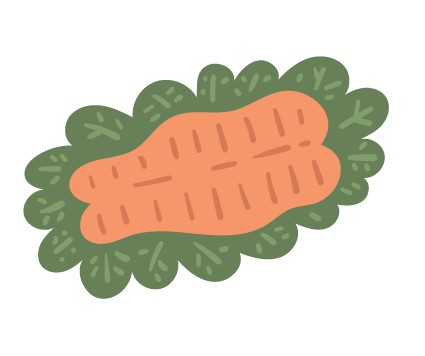
Written By Susan Moynihan / Illustrations by Shaw Nielsen

In a region that’s synonymous with great cuisine, it’s hard to narrow down our favorite Chesapeake Bay bites. But we tried. Here are 20 iconic ingredients and dishes with a history and flavor that speaks of home.


Clams
Soft clams thrive in the salty waters of the lower Chesapeake Bay, while the beds near Tangier and Chincoteague islands are a perfect breeding ground for hard clams. Try them packed into clear-broth chowder at Great Machipongo Clam Shack in Nassawadox, Va., or steamed in saké at Dredge in Irvington, Va.

Peanuts
Thank scientist George Washington Carver for transforming the humble peanut from West African import to one of the largest crops in eastern Virginia. Get them salted, butter-toasted, honey-roasted or Old Bay-coated at Virginia Diner in Wakefield, Va., which has been selling since 1929.

Hayman Sweet Potatoes
This smallish, syrupy-sweet tuber is a cult favorite, grown on Virginia’s Eastern Shore since the 1800s. Pick them up during fall harvest season (if you can; they sell out quickly!) at Red Horse Farm in Keller, Va., or Pickett’s Harbor Farms in Cape Charles, Va..

Sweet Corn
This creamy, white-kernelled treat is a summer staple, best served steamed and touched with butter and salt. You’ll find it at farm stands all over Maryland’s Eastern Shore, including chef-favorite Taylor’s Produce, which vends from multiple stands including St. Michaels, Oxford, and the family farm in Preston.

Lopes
The rich soil of the Eastern Shore is ideal for all sorts of produce, especially cantaloupe—or as we call them, “lopes.” This rough-skinned fruit is actually a muskmelon, which is sweeter and juicier than a true cantaloupe. And it’s a great source of vitamins A and C. Order them via a CSA (community-supported agriculture) group like Chesapeake Harvest, which vends organic and heirloom produce direct from Eastern Shore farmers.

Turtle Soup
Our diamondback terrapin was the featured ingredient in terrapin soup, found on swanky menus all over the Northeast during the Gilded Age—which eventually put them on the endangered list. Today, the terrapin is making a comeback on land, and it’s snapping turtle that you’ll find in the traditional soup served at Hunter’s Tavern in Easton, Md.

Biscuits
There is no one-size-fits-all approach to this perfect carb. Maryland’s traditional beaten biscuits have a firm, cracker-like texture, while Virginia’s delicate ham biscuits are the ideal delivery device for slices of Smithfield. The Everything-But-The-Bagel Cream Cheese Biscuits at Miss Shirley’s Café in Baltimore or Annapolis are a brunch must, while the traditional buttermilk version at The Bee & The Biscuit in Virginia Beach, VA, makes the perfect sandwich base.

Coddies
Sometimes called the poor man’s crab cake,
this homestyle patty is made of mashed potato, egg, and salt cod—deep fried and served between two saltine crackers. Their popularity waned in the 1970s but never went away, and the humble dish is now making a comeback in its home turf. Try them at the longstanding J.W. Faidley’s Seafood outpost at Baltimore’s Lexington Market.

Pit Beef
Maryland’s take on barbecue is grilled top round, sliced thin and topped with horseradish or a tomato-based BBQ sauce, served on a soft roll. Get the flavor at Pioneer Pit Beef in Catonsville, which sells them to go from a humble stand (cash only) and was singled out as top sandwich in Maryland by the Food Network.

Scrapple
This love-it-or-hate-it loaf of pork offal, cornmeal, and spices originated in Pennsylvania Dutch country, and is a breakfast staple throughout the Mid-Atlantic. Founded in 1863, Habbersett Scrapple in Bridgeville, Del., is the classic for store-bought, while Wilson’s General Store in nearby Georgetown is the standard bearer for scrapple sandwiches.

Crab Imperial
Legend has it this dish—a combination of crab, mayo and spices—was invented in the late 19th century at Baltimore’s long-gone Thompson’s Sea Girt House. The 1939 New York World’s Fair cookbook called it “the most typical of quality dining in all of Maryland.” Try it close to the source at Phillips Seafood in Baltimore’s Inner Harbor, or topping chicken or filet at Herrington Harbor’s Dockside Restaurant in Tracys Landing, Md.

Pawpaw
This humble fruit—a relative of the custard apple—is the largest native fruit in North America, and George Washington is said to have been a fan. Pick some up at Deep Run Paw Paw Orchard in Westminster, Md., or sample it in a delectable pie by James Beard-nominated chef Tarver King at The Restaurant at Patowmack Farm in Lovettsville, Va.

Shoofly Pie
No, there’s no such thing as a shoofly; the name for this molasses-based dessert is said to come from bakers who had to shoo flies away from their cooling pies, or from Shoofly the Boxing Mule, a traveling circus act in Pennsylvania’s Amish country. (Really!) You’ll find it at Pennsylvania Dutch markets throughout the region, or Dutch Haven Shoo-Fly Pie Bakery in Ronks, Penn. is a good road trip go-to.

Maryland Fried Chicken
Move over, Kentucky. Maryland fried chicken is our unique take on the Southern classic, with chicken pieces fried in a covered pan and then topped with a white gravy. You’ll be hard-pressed to find it on a menu these days, but there are recipes online (PreservationMaryland.org), or head to Gertrude’s in Baltimore, where celebrated chef John Shields serves it on Tuesday nights.

Stuffed Ham
St. Mary’s County, Md. puts its own twist on ham, stuffing it with cabbage, kale and spices. This tradition dates to post-Civil War days, when sharecroppers used the moisture from the veggies to soften up dried-out pieces of pork. It remains a holiday staple on local tables, but you’ll find them year-round near the source. WJ Dent & Sons in Tall Timbers sells them in person or by mail, or visit Murphy’s Town & Country in Avenue for a tasty stuffed ham sandwich.

Shad Roe
Every spring, Atlantic shad make their run up from the ocean to spawn in Bay-area rivers. The lobe-shaped roe sacks have a diehard culinary following, and appear in season on local menus, often paired with bacon or capers. It’s an acquired taste you can sample at Old Ebbitt Grill in D.C. and The Narrows on Maryland’s Kent Island, among other spots.

Blue Crab
What would we be without our blue crabs? These colorful crustaceans are synonymous with the Chesapeake, and prepared in every possible form: soup, cakes, balls, deviled, soft-shelled, topping chicken or pretzels, soft shelled, and more. Taste the diversity at Stoney Creek Inn in Pasadena, Md. or dig into all-you-can-eat steamed crabs at the Chesapeake Crab, Wine and Beer Fest, held in Baltimore, Richmond, and DC’s National Harbor.

Smith Island Cake
Whether you’re a purist who goes for the classic yellow-cake-and-chocolate-fudge combo, or a fan of the red velvet, lemon, or myriad other varieties, we can all agree one thing: Multiple layers gives this homegrown dessert an ideal icing-to-cake ratio.

Rockfish
The rest of the world calls them Atlantic striped bass or stripers, but we call them rockfish, due to their penchant for hiding in rocky nooks. Rockfish season follows their migration patterns, from the ocean back to the rivers of their birth. Try it paired with pesto risotto, crabmeat, and beurre blanc at Carrol’s Creek in Annapolis.

Oysters
We’ve been eating Bay oysters for a long time—some area middens date to 1500 BC or older—and our appetite led to the Oysters Wars between Virginia and Maryland watermen, and overfishing. Today they are on the rebound, with the rise of oyster aquaculture. Taste our native species, crassostrea virginica, at Virginia’s annual Urbanna Oyster Festival or the U.S. Oyster Festival in Maryland’s St. Mary’s County.
